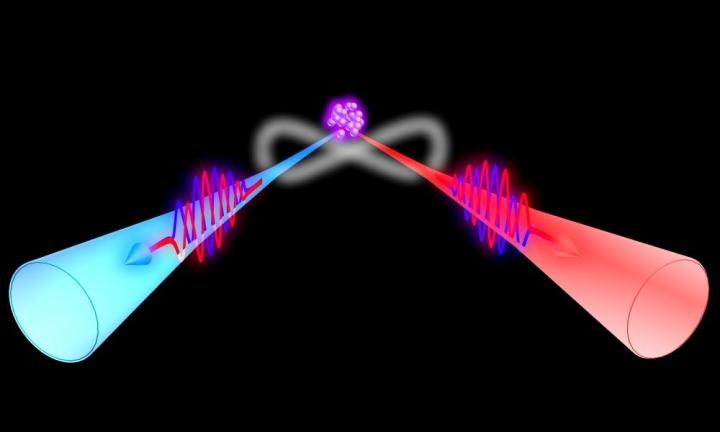May 8 2017
 This is quantum entanglement. CREDIT: Physics Department, HKUST.
This is quantum entanglement. CREDIT: Physics Department, HKUST.
A fascinating attribute of multi-particle quantum system that has developed as a basic building block of quantum computation as well as quantum information processing is quantum entanglement.
In the case of two entangled particles, regardless of the distance between the particles, quantum mechanics proposes that measurement of one particle results in the instantaneous wave-function collapse of the other particle.
This “spooky action at a distance” appears to be in contrast to our normal perspective. In the year 1935, Einstein made an effort to apply entanglement to condemn quantum mechanics, stating that quantum physics provides an insufficient description of physical reality. According to Einstein, any information cannot travel faster than light. He also proposed that specific local hidden variable theories can help describe the world in a deterministic manner, but only if they are in accordance with locality and realism. In the year 1964, J. S. Bell demonstrated that the debate can be experimentally settled by investigating an inequality. When the correlations between entangled parties are evaluated, the result obtained from local hidden variable theories must be restricted by the Bell inequality. On the contrary, this may be breached in predicting quantum mechanics.
Scientists from the Hong Kong University of Science and Technology have applied an explicitly created slow light technology for drastically minimizing the velocity of light to perform a Bell Test. Consequently, they were successful in generating frequency-bin entangled narrowband biphotons by means of spontaneous four-wave mixing (SFWM) in cold atoms with a double-path configuration. In this case, the phase difference between the two spatial paths can be regulated in a nonlocal and independent manner.
The outcomes of the research were published on 15 April 2017 in the journal Optica.
“We tested the CHSH Bell inequality and registered |S|=2.52±0.48|S|=2.52±0.48, which violates the Bell inequality |S|≤2,” stated Shengwang Du, leader of the research team and professor of Physics at HKUST. “We have unambiguously demonstrated the generation of frequency-bin entangled narrowband (about 1 MHz) biphotons, which can efficiently interact with stationary atomic quantum nodes in an atom-photon quantum network. Because of their narrow bandwidth, these biphotons can be stored and retrieved from a quantum memory with high efficiency.”
Our result, for the first time, tests the Bell inequality in a nonlocal temporal correlation of frequency-bin entangled narrowband biphotons with time-resolved detection. This will have applications in quantum information processing involving time-frequency entanglement.
Xianxin Guo, Scientist, Hong Kong University of Science and Technology
The research has uncovered the temporal details that are in close accordance with theory calculation based on quantum mechanics, and points over the probability of encoding and decoding qubit information in the time domain.
Our narrowband frequency-bin entangled biphoton source in this work can be ideally implemented to produce pure heralded single photons in a two-color qubit state with a tunable phase, making use of entanglement, linear optics, and time-resolved detection.
Xianxin Guo, Scientist, Hong Kong University of Science and Technology